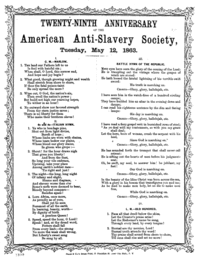American Anti-Slavery Society
The American Anti-Slavery Society (dt .: American Anti-Slavery Society ) was a 1833 by William Lloyd Garrison and Arthur Tappan founded American society, working for the liberation of the slaves began.
history
In 1831 the brothers Arthur and Lewis Tappan founded the first Anti-Slavery Society in New York. On January 1, 1832, William Lloyd Garrison founded the New England Anti-Slavery Society in Philadelphia , which soon spread across all New England states . Similar societies were formed in other cities. On December 3, 1833, their followers held their first major joint meeting in Philadelphia, whereupon they united to form the American Antislavery Society .
In 1835 the society had around 150,000 followers. In 1839 a group of members split off because of a dispute over various points. This included questions about anarchism, the women's movement, and religious hostility. In 1840 former members formed the American and Foreign Anti-Slavery Society group , including brothers Arthur and Lewis Tappan , Samuel Cornish and Theodore S. Wright . This split off group, for example, rejected equal rights for women. This split did not hinder the growth of the American Anti-Slavery Society . In 1840, 250,000 people were members of the AASS , including the writer Lydia Child , the suffragette Susan B. Anthony , Amelia Bloomer and the well-known abolitionist Wendell Phillips . They also received support from the Quaker religious community . The former slaves Frederick Douglass and William Wells Brown were the most famous members, often speaking at their meetings.
The company, which was headquartered in New York City , had about 1,000 employees and published 20 different magazines , including the National Anti-Slavery Standard.
After the American Civil War and the end of slavery, the society was dissolved in 1870.
Members
Other well-known members were: Elizabeth Cady Stanton , James G. Birney , Lucretia Mott , Lucy Stone , Augustine Clarke and John Greenleaf Whittier .
literature
- Owen W. Muelder: Theodore Dwight Weld and the American Anti-Slavery Society. McFarland, Jefferson 2011, ISBN 978-0-7864-6396-1 .
Web links
- American Anti-Slavery Society, "Constitution"
- THE AMERICAN ANTI-SLAVERY SOCIETY ( Memento from October 31, 2006 in the Internet Archive )
- The slave trade
Individual evidence
- ^ Henry Mayer: Schism . In: All On Fire: William Lloyd Garrison and the Abolition of Slavery , 1st. Edition, St. Martin's Press, New York 1998, ISBN 0-312-18740-8 , p. 282.
- ↑ Million, Joelle : Woman's Voice, Woman's Place. Lucy Stone and the Birth of the Woman's Rights Movement . Praeger, 2003, ISBN 0-8147-5676-X , pp. 22, 24-30, 33-35, 37, 39-41, 45-48.
